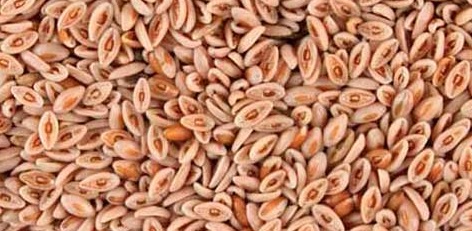
Psyllium, a very Interesting Fibre
Psyllium is a natural food ingredient with interesting nutritional and functional properties, and one of the most commonly used gluten substitutes in gluten-free bread production. In this entry, we will clarify what it is, its nutritional advantages, its functional properties, and the products in which we can use it.
Generally, when we talk about psyllium, we are referring to the husk of the seeds of plants of the genus ovata (typically Plantago ovata). The largest producer of this plant is India, with significant productions in Pakistan and Iran. In some cases, we encounter a product called psyllium husk, and in others, psyllium fibre. Both products are very similar, but the former has larger particle size, a darker colour, and more impurities. The latter is obtained by grinding the husk of psyllium, but its particle size is finer, and more impurities have been removed, both by screening and magnetic separation (magnets).
This powdered product is composed mostly of fibre (over 80%), and this fibre is predominantly soluble fibre. If we delve into the type of fibre, it is arabinoxylans, and therefore very similar to the fibre present in the endosperm of wheat or rye.
Nutritional Advantages
Numerous studies analyse the beneficial properties of psyllium against various diseases, such as ulcerative colitis, irritable bowel syndrome, or colon cancer. However, surely the most studied properties of psyllium are those related to constipation, cholesterol, and the risk of cardiovascular diseases. In fact, psyllium has long been used by the parapharmacy industry as one of the most effective remedies against constipation. This effect is related to its high capacity to absorb water, create viscous solutions, and regulate intestinal transit. In this way, it also reduces diarrhoeal problems. Regarding the reduction of the risk of cardiovascular diseases, this is related to the effect of psyllium on the release of glucose in the intestine, reducing it, and therefore reducing the glycaemic index of foods like bread. A similar effect is seen with cholesterol. Studies in this regard have led legislations in countries like Canada or the United States to allow healthy claims on the packaging of these products. Thus, in Canada, it is possible to include a phrase indicating that the product containing psyllium can reduce cholesterol, and in the United States another phrase indicating that it can reduce the risk of cardiovascular diseases. In both cases, when a certain level of psyllium is exceeded, around 1.7g per serving.
Given these properties, just for them, it would be interesting to incorporate psyllium into a food. But to do so, we must take into account its functional properties, or how it modifies the physical properties of the products in which it is incorporated.
Functionality
Regarding the functionality of psyllium, we must say that it is a product with a very high capacity for water retention and high thickening power. For a clearer idea, we can say that psyllium works very similarly to xanthan gum, a well-known product. But unlike xanthan gum, psyllium is not an additive. Therefore, here is another advantage of psyllium, which can be used in those products where xanthan gum is used, as a thickener or to retain moisture, without using an additive.
Uses of Psyllium in Cereal-Based Products
As we have said, we can use it in those products where xanthan gum is being used. So, in some cakes or bread, in small percentages, it can serve to increase the water absorption of the doughs or regulate their rheology. Also, to minimise the mobility of water inside the dough, as in parbaked bread. In larger percentages, in bread, it can help us to achieve juicier products since it retains a greater amount of water during baking, resulting in moister bread. But it will be necessary to increase the hydration of the doughs to avoid excessively hard doughs. However, where psyllium is most used is in the development of gluten-free bread. In fact, one of the most commonly used gluten substitutes years ago was xanthan gum, and as we have mentioned, psyllium behaves similarly. In a study on commercial gluten-free bread, we have seen that psyllium is one of the most used gluten substitutes, after HPMC and xanthan gum. But from our experience, we can affirm that the use of psyllium alone does not allow us to achieve the volumes obtained with HPMC, so we recommend using a mixture of psyllium and HPMC, where HPMC provides volume, and psyllium helps us achieve juicier and more cohesive crumbs.
Another potential use of psyllium lies in the possibility of reducing the oil content in certain formulations. Oil has the ability to increase the moistness of products like cakes, and this function can also be achieved by psyllium, by reducing water loss during baking and storage. However, oil serves some other functions, such as stabilising air bubbles in batters, which psyllium cannot perform. Our experience indicates that a mixture of psyllium and water can replace up to 75% of the oil in cake or muffin recipes, resulting in a significant reduction in calorie content. In the case of cookies, this reduction is more challenging as cookies have low moisture and a crispy texture, which is difficult to achieve with a high psyllium content due to its high-water retention capacity.
In the case of wheat bread, the incorporation of psyllium allows us to increase the hydration of the dough, achieve juicier bread, and very resilient crumbs (with great recovery capacity). However, one of the most interesting effects is that by retaining a large amount of water, we greatly reduce the calorie content of these breads. Nevertheless, it should be noted that when psyllium is incorporated, crispy crusts are not achieved, but rather soft breads, more similar to sandwich bread or bread with oil in its formulation.
Further information
Belorio, M., Gómez, M. (2020) Psyllium: a useful functional ingredient in food systems. Critical Reviews in Food Science and Nutrition.